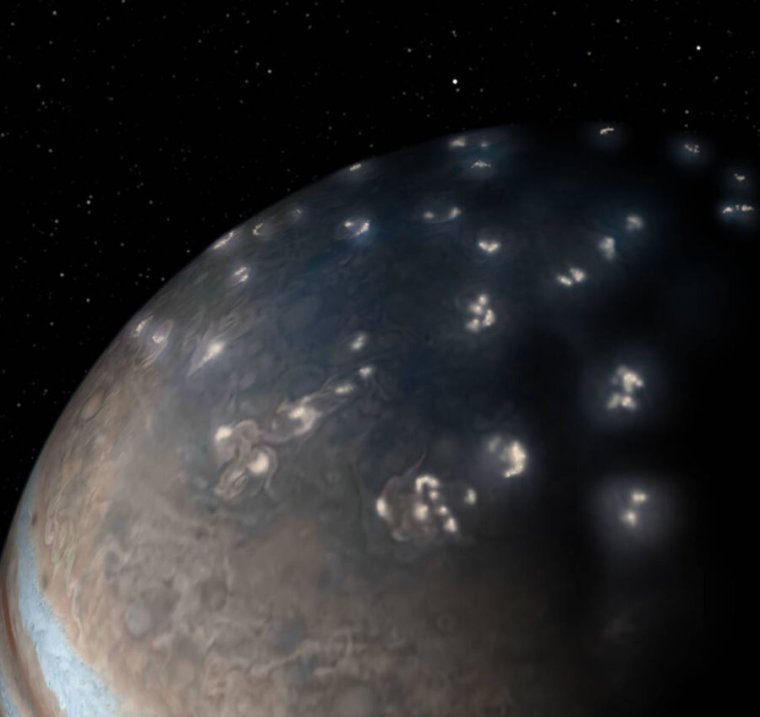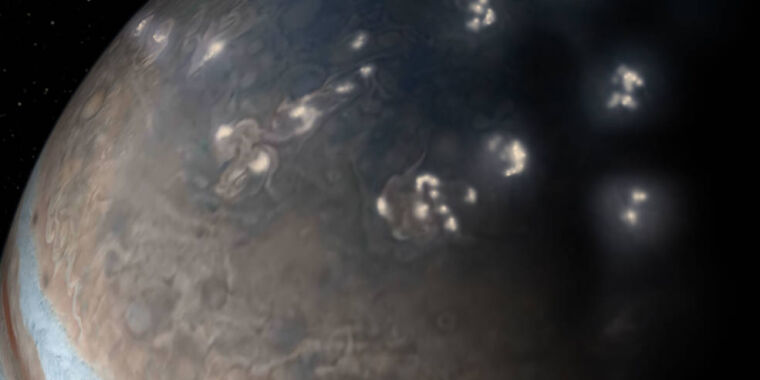
There are waves on Jupiter, but not exactly the kind surfers can ride. These plasma waves are much more intense than anything that crashes onto a beach.
NASA’s Juno spacecraft keeps coming across humongous plasma waves as it orbits Jupiter. These waves are actually known as Kelvin-Helmholtz instabilities (KHIs), and they occur when plasma from the solar wind interacts with the magnetopause of a planet, the outer level of its magnetic field. The difference in velocity between the magnetopause and solar wind creates a furiously swirling wave—a vortex.
“The Kelvin-Helmholtz instability may be observed at the boundary that separates a planetary magnetic field (magnetosphere) from the stream of charged particles emitted by the Sun (solar wind); this boundary is known as the magnetopause.” the researchers said in a study recently published in Geophysical Research Letters.
While these phenomena were previously known to happen on Earth and other planets and were suspected to occur on Jupiter, they had never been confirmed on the gas giant before Juno caught sight of them. The probe has spent so much time hanging out by the magnetopause on Jupiter’s dawn side that it was able to observe more of them than any other spacecraft or telescope has. Now a team of researchers from the Southwest Research Institute (SWRI) and the University of Texas at San Antonio have analyzed Juno data and investigated the waves in detail.
Waves rising
How do these waves wash up in space? Plasma, which is swarming with charged particles, is always being scattered throughout the Solar System by the solar wind, and it inevitably ends up interacting with plasma in the outer atmospheres of planets.
Jupiter is surrounded by a rotating disk of plasma that reaches its outer magnetosphere. At that location, there is magnetic tension at the interface between the planet’s magnetopause and the solar wind. This tension causes the plasma to have regional differences in velocity and direction; this is known as velocity shear.
If the velocity shear overwhelms the magnetic tension, the boundary of the magnetopause is disturbed and waves start to form. It isn’t only plasma from an external source like a star that can cause this—plasma from the magnetopause can also run into plasma from the level of the magnetosphere right below it. There is a particular high-velocity shear flow between the plasma in Jupiter’s magnetosphere and its magnetosheath, which lies right above the magnetopause. This shear also causes perturbations.
Waves that arise from such perturbations begin to roll until they end up as huge vortices. Though KH waves were only observed on the dawn side of Jupiter, it is also possible for them to form on the dusk side.
“Periodic fluctuations suggest that the spacecraft is traveling through a wave structure that is possibly a rolled-up vortex,” the research team also said in the study. “The spacecraft moves in and out of magnetosheath and magnetosphere plasma [during its orbit], crossing the boundary several times.”
Seeing the invisible
Juno was able to detect the otherwise invisible plasma waves with its hypersensitive instruments. Its Jovian Auroral Distributions Experiment (JADE) is made up of an electronics box and four sensors, three to seek out electrons and one to identify ions, the other component of plasma. JADE’s sensors are able to register information about the energy and location of these charged particles as it passes through the plasma. The magnetometers in Juno’s Magnetic Field Investigation (MAG) instrument suite measure the strength of Jupiter’s magnetic field, which determines whether it can be overcome by plasma from the solar wind and therefore cause a KH wave.
The swirling plasma waves observed by Juno are thought to push more charged particles throughout the magnetopause, and Juno data showed that the conditions were right for KH waves to form most of the times that it crossed the magnetopause on Jupiter’s dawn side. That doesn’t necessarily mean waves did occur. It picked up evidence for waves on only 19 crossings, so there is still some uncertainty about how often waves emerge when the right conditions are present.
Plasma waves that result from Kelvin-Helmholz instabilities can also be found in Earth’s atmosphere, but more form above Jupiter. It would still be impossible to ride an invisible wave. Surfers are better off catching monster waves in Jupiter, Florida.
Geophysical Research Letters, 2023. DOI: 10.1029/2023GL102921
Elizabeth Rayne is a creature who writes. Her work has appeared on SYFY WIRE, Space.com, Live Science, Grunge, Den of Geek, and Forbidden Futures. When not writing, she is either shapeshifting, drawing, or cosplaying as a character nobody has ever heard of. Follow her on Twitter @quothravenrayne.

